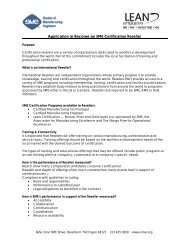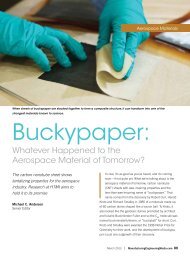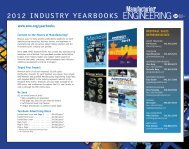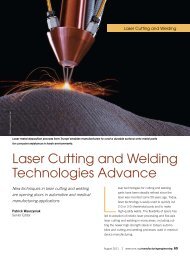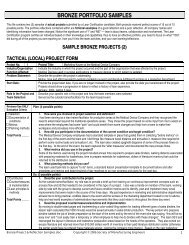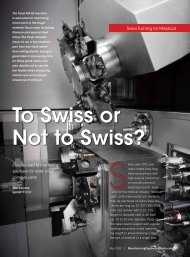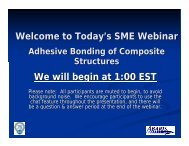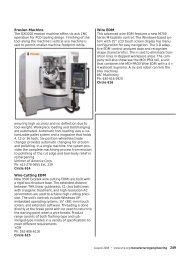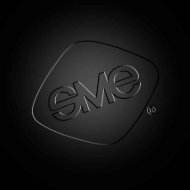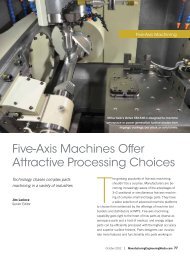The RAPID 2013 Conference & Exposition Directory - Society of ...
The RAPID 2013 Conference & Exposition Directory - Society of ...
The RAPID 2013 Conference & Exposition Directory - Society of ...
You also want an ePaper? Increase the reach of your titles
YUMPU automatically turns print PDFs into web optimized ePapers that Google loves.
ConferenCe Details<br />
Additive Manufacturing Applications I<br />
10 am–Noon<br />
Presentations detailing case studies and research and<br />
development activities that continue to advance the applications<br />
<strong>of</strong> additive manufacturing and 3D printing.<br />
10–10:25 am<br />
IT Enabled Technologies Disrupt Manufacturing<br />
Irene J. Petrick, PhD, Pr<strong>of</strong>essor, Penn State University<br />
In the past several decades, manufacturers have seen<br />
disruptions coming from competing production technologies<br />
and from low cost global competitors. Today and into the future,<br />
the disruptions are coming from sources many don’t even see<br />
coming. Specifically, the future manufacturing landscape will<br />
be enabled by developments in information technology. Access<br />
to high performance computing at a cost competitive rate will<br />
level the playing field for advanced modeling, analytics and<br />
simulation. When combined with developments in 3D printing/<br />
additive manufacturing, one-<strong>of</strong>f, highly customized production<br />
will compete with mass production. Current manufacturers will<br />
need to learn how these 3D printing/additive manufacturing<br />
technologies can coexist alongside their more traditional<br />
processes. As these tools become simpler to use, Internetsavvy<br />
hobbyists and do-it-yourselfers will effectively be able<br />
to challenge very established firms. Cloud supported services<br />
will be a viable replacement for extensive enterprise resource<br />
planning and customer relationship management systems, and<br />
will provide the real-time visibility into the supply chain and<br />
production environment that customers will demand. In the<br />
coming decade, the installed base that has been a barrier to<br />
entry for new firms will become a barrier to change for many<br />
established manufacturers.<br />
ceramic part, both before and after firing the material. Small<br />
quantity orders are <strong>of</strong>ten extremely expensive and accompanied<br />
by long lead times which can delay projects relying on the<br />
properties <strong>of</strong> ceramic components.<br />
3D printing not only allows for faster time to market, but also<br />
allows for more iterations during the design process, resulting<br />
in a better end product. Materials used in rapid ceramics range<br />
from less-hard alumina ceramics (aluminum oxide filler) to very<br />
hard and abrasion-resistant zirconia ceramics (zirconium silicate<br />
filler). <strong>The</strong>se ceramics can withstand between 2800ºF (1538ºC)<br />
and 3200ºF (1760ºC) working temperatures, and have a dielectric<br />
strength <strong>of</strong> 150 volts per mil. <strong>The</strong> alumina ceramic material<br />
is extremely abrasion-resistant, corrosion-resistant, and has<br />
excellent mechanical performance.<br />
11–11:25 am<br />
Unisource Engineering Solutions Uses Mcor<br />
3D Printing to Make More Realistic Packaging<br />
Prototypes<br />
Gary Fudge, Director, Americas, Mcor Technologies Ltd<br />
Unisource Engineered Solutions (UES) combines science and art<br />
to create high-impact product-packaging solutions.<br />
Challenge: Generating more sales and satisfaction with more<br />
realistic packaging prototypes. A staple in modern packaging<br />
design is thin-walled molded pulp. UES makes similar packaging<br />
from bamboo pulp and sugar cane residue called bagasse.<br />
Biopulp packaging elements include a hollow for each packaged<br />
part. Until recently, it’s been nearly impossible to provide the<br />
customer with a prototype whose texture better resembles the<br />
final product.<br />
10:30–10:55 am<br />
Breaking <strong>The</strong> Mold—3D Printing Engineering<br />
Grade Ceramic Materials<br />
Benjamin Becker, BS, Managing Director, HotEnd Works, LLC<br />
UES had instead been settling for plastic prototypes which<br />
are fine for form and fit, but the look and feel is nothing like<br />
thin-walled molded pulp, which has greatly impeded sales and<br />
negatively impacted customer satisfaction.<br />
Expensive post processing <strong>of</strong> the ceramics is <strong>of</strong>ten required<br />
either to create intended geometries that could not be created in<br />
the initial machining state, or to bring the part within the design’s<br />
tolerance. Investment in carbide or diamond tooling and fixturing<br />
is <strong>of</strong>ten necessary in order to create certain features on the<br />
Strategy: 3D printing prototypes with paper.<br />
38 sme.org/rapid





